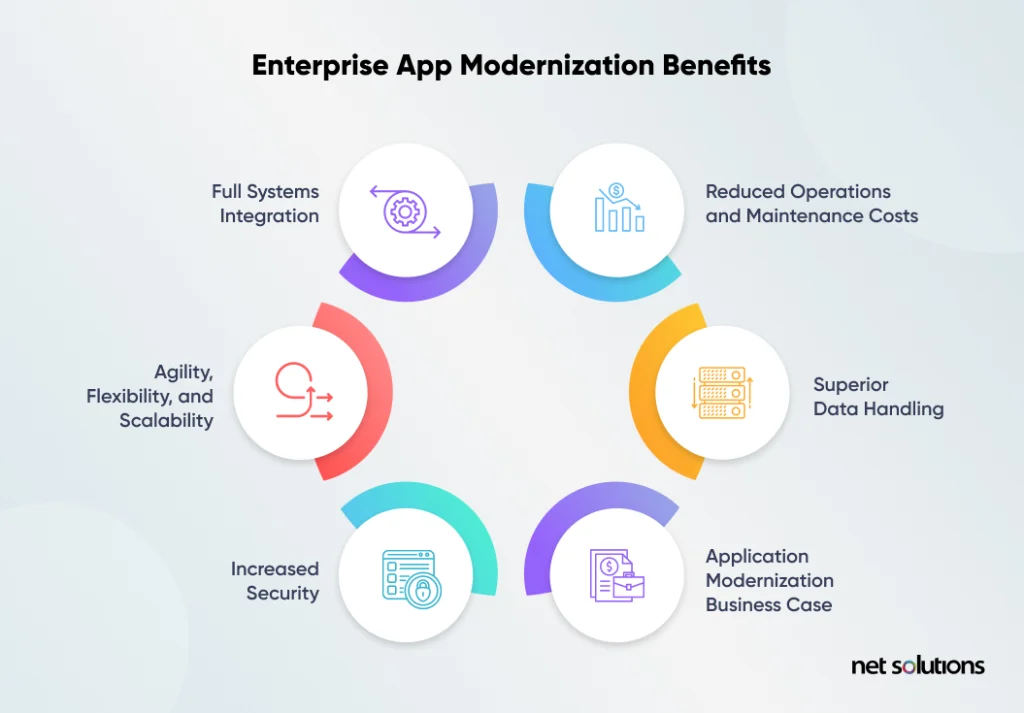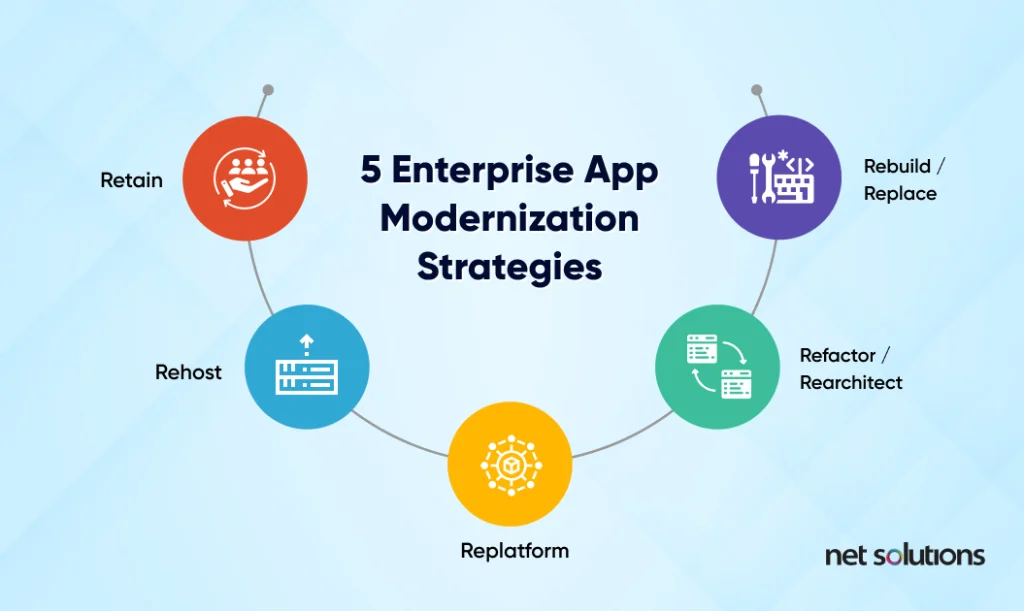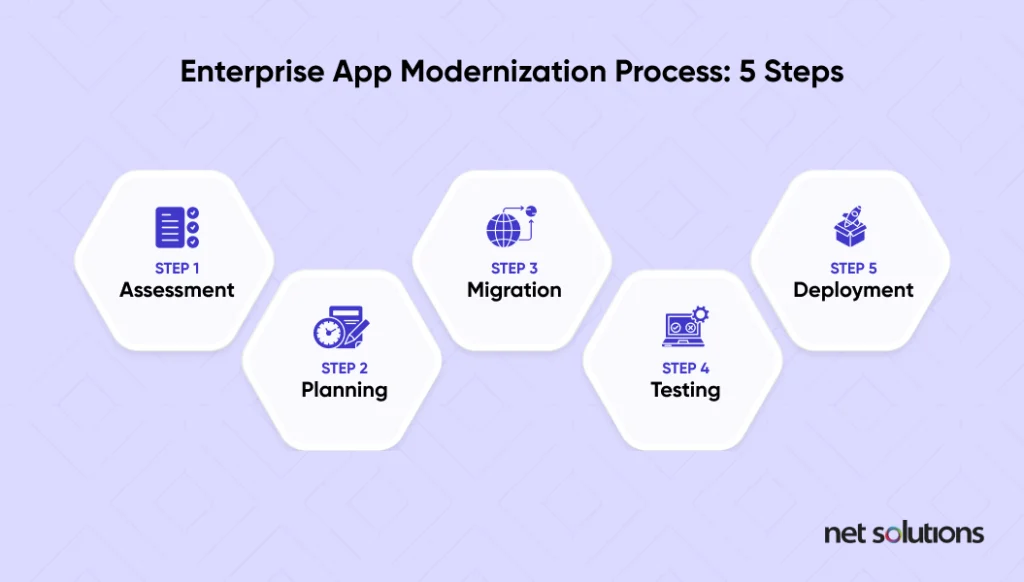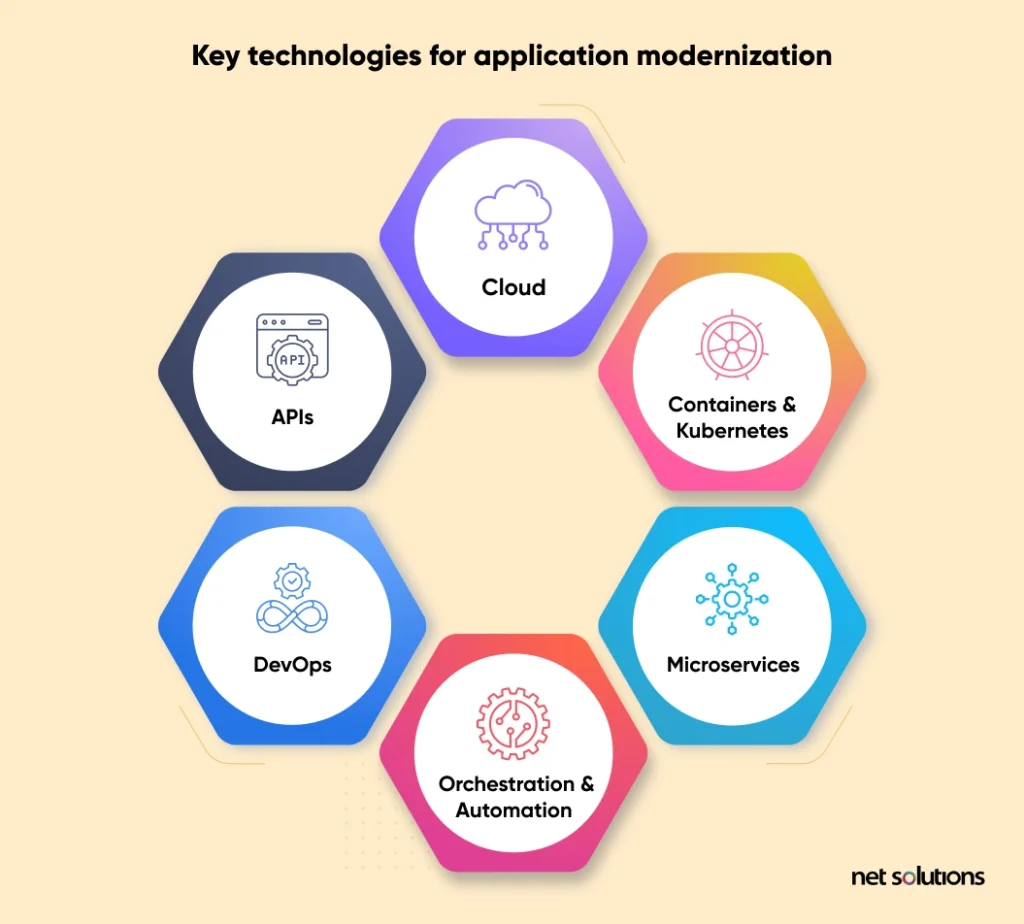Large organizations face specific challenges regarding digital
transformation—challenges that small and midsize businesses don’t always face.
The sheer volume of interconnected systems, data, and infrastructure makes
moving legacy applications to a cloud infrastructure much more complicated for enterprises, and
successful implementation requires a great deal of foresight and planning.
We wrote this guide to help large companies take a modernization approach
that fully meets their users’ demands and supports their overarching business needs.
What Is Enterprise Application
Modernization?
Enterprise application modernization updates business
applications, infrastructure, and architecture to work seamlessly in the cloud. It often
involves using cloud-native apps and microservices to increase the functionality of the overall
business system.
Application modernization strategies are not just about cloud migration. That’s
part of the equation, but a simple “lift and
shift” won’t allow you to take full advantage of everything cloud
computing offers.
Successful enterprise application modernization involves carefully
considering the role existing
applications play. It means identifying where they fall short of delivering a powerful customer
experience and which measures you need to take to ensure seamless integration and optimization.
What Makes Enterprise
Application Modernization Challenging?
What makes app modernization and digital
transformation different at the enterprise level? What
unique challenges do large organizations face?
It’s a bit like city planning in a metropolis like New York, compared to city
planning in a small suburb of 20,000 people.
Managing public transportation in the suburb might include two or three bus
routes, each
connecting citizens to commercial centers, business parks, and schools.
On the other hand, New York has a vast, complicated system of subway lines,
buses, and light rails, along with taxis to manage and bridge tolls to collect. Changing just
one bus route or taking a handful of trains “offline” for maintenance can impact the entire
system, creating bottlenecks for commuters and impacting everyone’s life.
The same applies to the apps and infrastructure that support enterprise IT
systems.Application
modernization has numerous benefits, but you must do it strategically to avoid creating
chaos and impacting profits.
Why Is Enterprise App Modernization
Important?
Large enterprises rely heavily on powerful software systems to serve
customers and manage internal
operations. Those working with legacy
systems will need more support in serving customer needs, operating efficiently, scaling
properly, and remaining competitive.
Here are some benefits large companies experience when successfully
transitioning to modern applications that run on a cloud platform.

Full systems integration
Application modernization isn’t just about adopting interesting new
technologies that improve the user experience. The business case for modernization runs much more
profound.
Legacy
applications stored on-premises are not compatible with today’s SaaS and cloud-native
solutions, and incompatibilities can:
- Produce technical failures
- Impact workflows and productivity
- Chew up valuable resources by creating workarounds that result in technical debt
- Lead to lost business and a damaged brand
Application modernization involves introducing more cloud-native apps that
employ a microservices architecture. For legacy applications,
you need to retain them for whatever reason. It might involve creating an API layer that allows
them to integrate with more modern apps and infrastructure.
Whichever combination of application modernization strategies you employ,
the ultimate goal is a fully integrated system that serves your current business needs.
Reduced Operations and Maintenance Costs
Application modernization may seem expensive when you only consider the
upfront pricing, but a massive opportunity cost comes with a refusal to modernize. A recent
Forrester study found that enterprise app modernization produces an ROI of up to 228%.
Legacy applications become less efficient and bloated as you add new features,
and maintenance costs increase yearly.
Switching to a cloud-based, modern architecture can reduce costs, thanks to:
- Lower demand for tech support
- Less labor spent building workarounds
- More efficient data storage
- Greater efficiency
- Increased competitiveness
- Better security with fewer maintenance hurdles
Security is paramount because legacy systems might risk your customers’
data, seriously impacting your brand in ways that are impossible to quantify.
Agility, flexibility, and scalability
Cloud-based technology is far more flexible and scalable than monolithic
legacy systems, and that’s vital as businesses grow. Modern apps and infrastructure can handle
the peaks and valleys of traffic and user requests.
Enterprise app modernization improves:
- System responsiveness
- Workflow efficiency and increased automation
- The overall user experience (for both internal and external users)
- Access to the latest Artificial intelligence
(AI), Machine Learning (ML), and Internet of Things (IoT) technology
Cloud services like Amazon Web
Services (AWS) use a pay-as-you-go pricing model, meaning that as your workloads
increase, you simply pay more for the higher use. When workloads decrease, you pay less.
All this results in a more agile, flexible system that allows you to adapt
to changes in your business, the market, and the overall economy.
Superior data handling
Legacy applications typically don’t have the data-handling capabilities
of their modern counterparts. When older apps collect data, it’s often siloed and challenging to
analyze.
Modern apps feed into centralized data centers, allowing you to gain insights
into your business processes, customer behavior, and many other aspects of your business.
To take full advantage of modern Digital Experience Platforms (DXPs), you need a
cloud-based infrastructure that works with modern apps.
Increased security
Cybersecurity is constantly changing, with new threats appearing all the
time. In this epic battle between black-hat hackers and white-hack hackers, legacy applications
and outdated platforms become easy targets.
Legacy systems fall short because they don’t always receive security updates
and patches and may rely on software from third-party vendors who are no longer in business.
They may not have the latest cybersecurity technology built into their backend.
In the end, application modernization is a solid investment when done right.
Doing it correctly, of course, requires careful strategy and a solid business case. You will
present that business case to company leaders and key stakeholders.
Application modernization business case
Large organizations have many levels of management, and decisions require
numerous checks and balances. It’s just the nature of operating a large enterprise.
Unlike a startup, where IT teams can make decisions quickly, enterprise IT
teams must make a business case for even the smallest changes. And when it comes to something
all-encompassing like app modernization, you must define your business needs clearly.
That’s where the business case comes into play. Your business case should
provide a full project description that outlines the following:
- Current problems that legacy systems create
- Business impact of those problems and how app modernization can solve them
- Estimated cost of app modernization
- Benefits and potential ROI of digital transformation
The business case will also help you sell the value of app modernization
to the rest of the company long after executives have signed off on the project. Buy-in at all
levels will help ensure your success.
App Modernization Strategies
Enterprise app modernization isn’t always a matter of adopting entirely
new, cloud-based apps to address every business need. App modernization is a significant,
time-consuming endeavor, and you’ll likely take a different approach to each software system
based on your circumstances.
Critical applications are the first you want to address, but how you deal with
each will depend on your current resources, requirements, and how that app interfaces with other
apps.
Here is a brief guide to seven app modernization strategies based on AWS’s
7R model. We go into greater detail about these strategies in our definitive guide to app
modernization.

Retire
Retiring an app means taking it out of service entirely. Make sure you no
longer require an app before retiring it.
Retain
You can retain a legacy app by wrapping an API layer around it, allowing
it to interact with modern cloud-based apps while remaining intact at its core. It won’t have
the powerful functionality of a modern app, but it can serve your immediate needs and keep your
workflows moving.
Relocate
You can relocate workloads without rewriting the source code or
purchasing new infrastructure. An example would be taking an onsite Kubernetes platform and
transforming it using AWS’s cloud-based Elastic Kubernetes Service (EKS).
Relocating is an efficient solution with minimal disruption but it doesn’t
allow you to take full advantage of cloud technology.
Rehost
Infrastructure-as-a-Service (IaaS) platforms allow you to redeploy
workloads on the cloud, known as rehosting. In many cases, it’s a quick, painless option, but it
doesn’t come with all the benefits of cloud-native solutions.
Repurchase
You can swap out internal systems for external systems—this is known as
repurchasing. You would have a third-party provider monitor and manage the new system, switching
to a use-based consumption model. It costs more than the strategies mentioned above but offers
powerful cloud-native capabilities.
Replatform
Replatforming describes transitioning applications to a cloud-based
infrastructure. It’s not the complete overhaul that refactoring constitutes, but it offers many
of the same benefits, such as API-first
apps, microservices, and headless architecture.
Refactor
Refactoring is the most comprehensive app modernization strategy you
can take. It involves completely rearchitecting an entire system’s workloads, providing optimal
flexibility and cloud-native functionality. It’s more expensive, but it’s also the most
future-proofed solution.
App Modernization Process
As with any significant undertaking at the enterprise level, you’ll
need to map out a clear process and follow it throughout your modernization journey. The
following five steps and best
practices will help guide your app modernization initiative.

Assessment
During the assessment stage, you and our team will study your current application architecture and solicit feedback from department heads, end-users, and key stakeholders.
To support your assessment efforts, be sure to:
- Meet with leaders and collect feedback from end-users
- Consult technical experts to understand your current needs
- Research the latest technology
- Identify your highest priorities
- Highlight any skills and knowledge gaps within your internal team
- Explore options for working with outsourcing partners to fill any gaps and help reduce costs
It shouldn’t surprise you if your current team doesn’t have the time or expertise to handle every aspect of your app modernization project.
This isn’t something in-house teams handle very often, and they’re likely burdened with their day-to-day tasks. Working with an =outsourcing partner can guide and supplement your efforts.
Planning
Careful planning is essential to achieving a successful digital transformation. During this phase, identify who will handle your app modernization, which apps they will target, and other key concepts.
When planning your app modernization project, identify the following:
- App modernization team members (both in-house and external)
- Legacy apps to target
- App modernization strategies
- Dependencies between different apps
- Project timelines with milestones for each component
- Application development requirements
- Infrastructure approach (e.g., hybrid cloud, multi-cloud)
- Plan for communicating deployment and any disruptions to users
- Key Performance Indicators (KPIs) and other metrics to objectively rate your success
Planning provides a roadmap for success that will guide your implementation and ensure you’re using your resources effectively.
Migration
The migration itself is the most critical part of the app modernization process, and it’s where several things could go wrong if you’re not vigilant.
Rather than spelling out every step in the migration process, we’ll provide a broad overview of some essential things to consider at this stage. Look at our 17-step cloud migration checklist to ensure you get it right.
Evaluate all potential data sources (e.g., databases, files, user-generated content) and choose a migration (online, offline, or hybrid) based on the following variables:
- Data volume
- The overall complexity of your project
- Tolerance for system downtime during the migration
- Security rules and regulations
- Data-handling protocols within your company and industry
Again, there’s much more to handle during a migration—these are just some key themes. Our migration checklist offers a deeper analysis of each step.
Testing
Testing is also a key element of cloud migration, helping to ensure that the new system is ready for deployment. You don’t want to deploy your software and discover there are issues you could have prevented beforehand with proper Quality Assurance.
Testing and validating include:
- Functional testing to ensure the new applications do what you expect them to do and that all the data migrated correctly to the new platform
- Performance testing to evaluate how the systems perform under various conditions. This typically involves load testing, stress testing, and endurance testing.
- Security validation to protect your and your clients’ data
- Compliance review to make sure you’re adhering to regulations and industry standards within your new system
At Net Solutions, we take an Agile, DevOps-based approach to software testing to ensure a safer, more successful application modernization process.
Deployment
A successful deployment is everyone’s goal. Before deployment, perform a final data synchronization and update all your DNS and network configurations.
Following deployment, you’ll need to monitor performance and continue to optimize your new ecosystem. Note any issues and regularly work to improve the functionality.
You’ll make improvements along the way, fine-tuning your legacy modernization efforts in the following days and weeks.
App Modernization Technologies and Frameworks
Modern apps employ the latest technologies to work with the cloud and interface seamlessly with other modern applications. This technology is the very thing that makes these apps flexible, scalable, powerful, and efficient.

Modern apps use the following technologies and frameworks to achieve
operational efficiency and help enterprises achieve their goals.
- Cloud-native by design: Modern apps are made for the cloud and interface with other
apps perfectly in a cloud environment. - APIs: Modern apps take an API-first approach, placing APIs at the core of their
product design. This opens the door to a wide range of flexibility, interaction between
apps, and containerization to reduce dependencies. - Containers and Kubernetes: Kubernetes, a container management platform, allows modern
apps to hold all the information they need to function (code, libraries, etc.) in
containers. This creates a united data pool and offers broad functionality, decreasing
dependencies and allowing backends to serve multiple purposes. - Microservices: Different software components can use separate microservices within an
app or an ecosystem of apps. Every microservice communicates through an API, extending the
functionality of each component and making it easy to scale and swap different components. - Orchestration and Automation: Modern apps use all these technologies to orchestrate
between one another to achieve greater efficiency. - DevOps: DevOps is a model for software development that involves building, testing,
releasing, monitoring, and planning. The cycle repeats continuously, with fresh information
guiding each new release. The best application modernization services take
an Agile, DevOps-style approach centered around continuous delivery and improvement.
These technologies and ideas work in conjunction with one another. They create
a superior framework for building and deploying the software systems that power large
enterprises.
App Modernization Case Studies
Net Solutions has developed modern software for large organizations
worldwide, from the Harvard
Business Review to IMG. We’ve been in the
software business for over three decades and helped countless leaders modernize their IT
systems.
Here are two case studies
describing our work on the app modernization front.
American Golf
A leading retailer of golfing equipment, American Golf, hired us to
modernize its eCommerce website and systems.
Our work with American Golf involved:
- Designing and building a new eCommerce platform
- Implementing MS Dynamics NAV
- Designing discount management technology that is easy for staff to use
- Integrating workflow-based fulfillment tools
- Designing and building a user-friendly dashboard with full analytics capabilities
Read the complete case study to explore the details.
Bonds of London
Bonds of London hired Net Solutions to modernize its internal sales app and its customer-facing eCommerce app .
Our work with Bonds of London included:
- SAP Integration
- Customized eCommerce app with Magento
- The creation of an app that offers personalized, rules-based discounts to clients
- A user-friendly customer portal that sales staff can access
Learn more about our work with Bonds of London.
Start Your App Modernization Process
Net Solutions has worked with international brands, from Euro Car Parts to 2XU, helping them develop modern technological solutions.
Talk to our experts to implement modular, future-proof tech infrastructure, giving your organization the competitive edge it needs to thrive in an ever-changing world.
SHARE THIS POST
Table of Contents
Related Services
Related Resources
- A Framework-based Approach for App Assessment
- App Modernization Benefits To Boost Your ROI and Future-Proof Your Business
- 11 Top Application Modernization Best Practices in 2025
- Building a Winning Application Modernization Business Case
- Legacy Application Modernization Case Studies & Success Stories
- Solving the Toughest Application Modernization Challenges
- Cloud-Native Application Modernization: Benefits & Strategies
- 8 Core Application Modernization Drivers
- Lift and Shift: The Modernization Formula for Legacy Apps
- Navigating Application Migration and Modernization [Guide]
- Application Modernization and Optimization: A Complete Guide
- A Practical Approach to Application Rationalization: A CIO's Guide to Managing Complexity and Reducing Costs
- What is Replatforming? A Beginner's Guide to Upgrading Your Technology Stack
- 7 Steps to Build an Effective Application Modernization Roadmap
- Application Modernization Services Market: Comprehensive Analysis
- A Step by Step Guide to Application Modernization Strategy
- Explore the Best Application Modernization Tools and Resources
- 13 App Modernization Trends That Can Support and Optimize Your App Modernization Strategy



